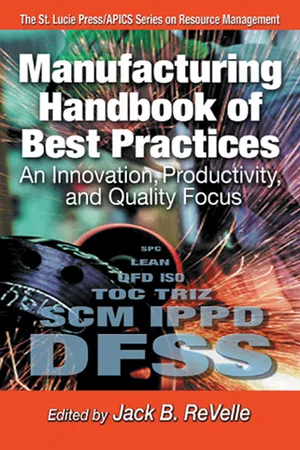Business
Constraints
Constraints in business refer to limitations or restrictions that affect the operations, decision-making, and growth of a company. These can include financial constraints, resource limitations, regulatory requirements, or market conditions. Identifying and managing constraints is crucial for businesses to optimize their performance and achieve their objectives.
Written by Perlego with AI-assistance
Related key terms
1 of 5
3 Key excerpts on "Constraints"
- Özer Özcelik, Adil Akinci(Authors)
- 2019(Publication Date)
- Peter Lang Group(Publisher)
Following hypotheses are argued by the theory of Constraints; each system has a purpose; it is expected from a system to increase the success about the goal; the success of each system is limited by the Constraints (Kolinska and Domanski, 2017:110). According to hypotheses, these Constraints and obstacles need to be known and defined well for business system or process success. Constraint types are differently defined in the literature. Ruhl (1996:44) defined the Constraints as the internal Constraints (management Constraints, workers’ attitudes, the capacity of the production process) and external Constraints (variables like the market demand that the enterprise cannot interfere). Atwater and Gagne (1997:7) defined the Constraints by five different categories; market Constraints (lack of the enough market demand to completely use the production capacity to produce the relevant product); resource Constraints (lack of the capacity of a resource to meet the market demand); politic Constraints (management rules that limit the ability of using the opportunities); raw material Constraints (shortage of raw materials or materials supplied externally); logistical Constraints (transmitting the required materials to the company and also transmitting the orders completed). The most frequently used Constraints are as follows; phys- ical Constraints (machine, manpower, job station capacity, lack of material, etc.); managerial Constraints (policies, criteria of thoughts caused Constraints in work- flow); market Constraints (inadequate demand) (Krajewski et al., cited: Birgün, 2013:264; Pozo et al.,2012:8). Approach of Theory of Constraints 233 Theory of Constraints contributes to business management and develop- ment by two significant components. One of this component is the thinking process (a number of tools that looks for systematic solutions to problematic and complicated situations).- eBook - PDF
Manufacturing Handbook of Best Practices
An Innovation, Productivity, and Quality Focus
- Jack B. ReVelle(Author)
- 2001(Publication Date)
- CRC Press(Publisher)
Although the concept of Constraints limiting system performance is simple, it is far from simplistic. To a large degree, the constraint/nonconstraint distinction is almost totally ignored by most managerial techniques and practices. Ignoring this distinction inevitably leads to mistakes in the decision process. The implications of viewing organizations from the perspective of Constraints and nonConstraints are significant. Most organizations simultaneously have limited resources and many things that need to be accomplished. If, due to misplaced focus, the constraint is not positively affected by an action, then it is highly unlikely that real progress will be made toward the goal. A constraint is defined as anything that limits a system’s higher performance relative to its purpose . When looking for its Constraints, an organization must ask the question, “What is limiting our ability to increase our rate of goal generation?” FIGURE 18.1 The 40,000 ft perspective. (Courtesy of Chesapeake, Inc., Alexandria, VA.) 386 The Manufacturing Handbook of Best Practices When we’re viewing an organization from the functional perspective, our list of Constraints is usually long. When we’re viewing the organization from the 40,000-foot perspective, we begin to consider it as an interdependent group of resources, linked by the processes they perform to turn inventory into throughput. Just as the strength of a chain is governed by its weakest link, so is the strength of an organi-zation of interdependent resources. 18.1.3 T WO I MPORTANT P REREQUISITES TOC prescribes articulated a five-step improvement process that focuses on manag-ing physical Constraints. - Mark Woeppel(Author)
- 2000(Publication Date)
- CRC Press(Publisher)
The Goal is a good example of this. You never saw any fundamental change in the manufacturing plant discussed in the book except in the management of it! Material Constraints Material Constraints are the least common. These are usually things such as scarce materials, but can also be a commonly available material that is in short supply due to problems in the supply chain. Several years ago, after a fire at a major computer chip manufacturing plant in Japan, chips were in short supply. Computer manufacturers reacted by offering high-end machines that were loaded with profitable options. This was their way of exploiting the shortage of a critical component. They just stopped making the basic, low-profit machines. The distinction of whether a given constraint is a policy, resource, or material is mostly academic. Your concern as a manager is how best to manage the resources available to achieve the goal. I have included distinctions to 14 Manufacturer’s Guide to Implementing the Theory of Constraints point out that most of your Constraints are not resources, but are policies that govern resource utilization. Therefore, the implementation is focused on policy and procedure development, rather that process improvement. Focusing Steps of Constraint Management Because the organization’s performance is limited by its constraint(s), our process to manage the chain must ensure the constraint is the focal point of everything we do. The following steps allow us to focus: 1. IDENTIFY the system constraint(s). 2. Decide how to EXPLOIT the identified constraint(s). 3. SUBORDINATE everything else in the system to step #2. 4. ELEVATE the system’s constraint. 5. GO BACK TO STEP #1. Identify the System’s Constraint(s) Identifying the system’s constraint(s) is essential. If you do not know the location of your constraint, you do not and cannot understand your business. The constraint determines many aspects of your business: output, profitabil-ity, return on investment.
Index pages curate the most relevant extracts from our library of academic textbooks. They’ve been created using an in-house natural language model (NLM), each adding context and meaning to key research topics.


